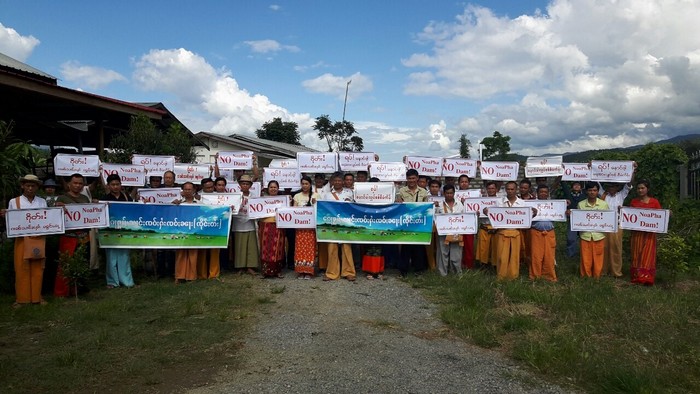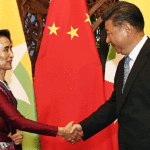Shan Human Rights Foundation (SHRF) | August 23, 2016.
Concerns about the Naung Pha dam on the Salween River
By Action for Shan State Rivers
Date: August 23, 2016
| Background facts about Naung Pha dam | |
| Location: | on the Salween River, between Lashio and Ho Pang townships in N. Shan State |
| Height: | 90 m |
| Installed capacity: | 1,200 megawatts (90% for export to China) |
| Reservoir size: | 31.28 km (backwater length 110 kms) |
| Companies involved: | Hydrochina Corporation (China – state-owned)
International Group of Entrepreneurs (Burma) |
| MOU signed: | December 2009 (in presence of future Chinese President Li Xinping) |
| MOA signed: | March 2014
Environmental and Social Impact Assessment (ESIA) being carried out by Australian Snowy Mountains Engineering Corporation (SMEC) – due for completion in Sept 2016 |
Key concerns about the Naung Pha Dam
We are strongly opposed to any dams on the free-flowing Salween River, a vital artery sustaining millions of ethnic people in eastern Burma. Any blockage to its mighty flow would have far-reaching environmental and social impacts. However, the general perception in central Burma appears to be that the Salween is at a remote edge of the country, and dams will have little impact. In particular there is little public knowledge about the Salween in “remote” northeastern Shan State. We therefore wish to highlight some specific concerns about the Naung Pha Dam as follows:
Fueling Conflict
The Naung Pha dam is situated in an active conflict area. West of the dam site and projected reservoir area, the Burma Army and its militias are carrying out offensives against ethnic armed groups including the Shan State Progress Party/Shan State Army (SSPP/SSA), Kachin Independence Army (KIA), and the Ta’ang National Liberation Army (TNLA) to seize control of their areas and local natural resources. None of these groups signed the Nationwide Ceasefire Agreement (NCA) on October 15, 2015.
To the east of the dam site lies the Wa Self-Administered Region, controlled by the heavily armed United Wa State Army (UWSA), which also did not sign the NCA. There has been ongoing tension between the UWSA and the Burma Army over territorial issues, as only part of the UWSA-controlled areas are recognized as the Wa Self-Administered Region under the 2008 Constitution. The Burma Army have repeatedly ordered the UWSA to withdraw from its southern territories along the Thai border, but the UWSA has refused, leading to military build-up on both sides, and even erupting into fighting in June 2015.
If the Naung Pha dam starts to be built, the Burma Army will definitely reinforce its troops to secure the dam-site, and launch operations to clear ethnic armed groups from the area. This will cause more conflict, and ongoing Burma Army abuses of local villagers suspected of supporting the ethnic armed groups
Furthermore, Naypyidaw’s recent unilateral decision to proceed with the Salween dams including the Naung Pha dam — despite strong opposition by ethnic communities all along the river, is directly contrary to the government’s claimed commitment to peace. A key root cause of the conflict is ethnic resentment of central government exploitation of natural resources in their areas. Thus, selling off the Salween to foreign investors even before political dialogue about federal power sharing has begun, throws into doubt the government’s willingness to recognize the demands of ethnic peoples for equal rights, and bodes ill for the peace process.
The Burmese government’s claim that it needs to build the Salween dams to address Burma’s energy needs is also false, as most of the power from the five planned dams will be exported to neighbouring countries. 90% of the 1,200 megawatts produced by the Naung Pha dam will be exported to China, while local people in Burma will have to bear all the costs.
China’s role in pushing the Burmese government to accept the unpopular Salween dams, in order to meet Chinese power needs, should also be criticized. Given the dams’ potential to fuel conflict, this is direct interference in Burma’s internal affairs and disruption of a peace process China is claiming to support.
Chinese pressure on the UWSA to accept the Naung Pha dam, despite the damaging impacts on local communities, also deserves criticism. It pits the UWSA against its grassroots constituency, as well as against other ethnic armed groups who are opposed to the Salween dams, fuelling ethnic divisions that will not be conducive to peace.
Risk of dam breakage from earthquakes
Yunnan province is one of the most earthquake prone areas of China. The fact that the Salween/Nu river runs directly along the Nu River fault lines, was one of the main reasons why the Chinese government suspended its plans to build dams on the river inside China. According to Chinese earthquake specialists, the weight of water in a dam reservoir above a fault line is likely to trigger earthquakes.
The areas of northern Shan State adjoining China are also earthquake prone. The Naung Pha dam is located close to the Nampawng fault line, and its reservoir will extend up to the Nam Ting fault line. During July to August, three earthquakes took place in Ho Pang township, along the Nam Ting fault.
Villagers living downstream of the Naung Pha dam are therefore extremely fearful about dam breakage, and the large-scale loss of life and property which would be caused by the sudden massive flood of water released.
There are similar concerns about the 1,400 megawatt Kunlong dam, planned by Chinese Hanenergy on the Salween river, just north of the Nam Ting fault line. If an earthquake caused the Kunlong dam to break, the entire town of Kunlong, which lies just south of the dam, would be devastated by the resulting torrent of water.
Increased risk of flooding
The dam reservoir of the Naung Pha dam will be 110 kms long, reaching up to the mouth of the Nam Ting river. Already there is seasonal flooding along the Nam Ting, which last month caused damage to thousands of acres of farmland, and last week wrecked property in downtown Ho Pang. If the Naung Pha dam is built, the rate of water drainage along the Nam Ting will be further reduced, meaning an even greater likelihood of flooding and damage to crops and homes in the Nam Ting valley.
Heavy flooding above the dam may also necessitate a sudden release of a large volume of water from the dam, causing a dangerous water surge downstream.
Concerns about SMEC’s ESIA for the Naung Pha dam
In 2015, SMEC attempted to carry out an ESIA for the 7.000 megawatt Mong Ton dam on the Salween in southern Shan State. However, widespread public protests against the dam blocked SMEC from carrying out the ESIA in several townships.
To prevent a repeat of these protests, SMEC has been carrying out the ESIA for the Naung Pha dam in secrecy. There was no large public meeting in the Shan capital of Taunggyi to announce the start of the ESIA, as had taken place with the Mong Ton ESIA. People invited to the local “public consultations” in towns such as Kunlong and Ho Pang were only informed a few hours in advance of the meetings.
Participants anyway voiced concerns about the dams at the public consultations. In Ho Pang, a township official spoke out against the dam due to fears of flooding in his area. However, the promotional website for the Naung Pha dam (naopha.com) states that the public consultations were “successful” and that people asked the company “to construct the project as soon as possible”.
As a result, local communities have been rallying against the dam. On August 5, 2016, about 250 people from nine village tracts in Tangyan, including the Shan Nationalities League for Democracy (SNLD) MP for Tangyan, held a protest against the dam.
Contact
Sai Khur Hseng +66 81 6722 031 +95 92 6436 2973
Nang Charm Tong +66 81 630 6655
Sai Hor Hseng +66 62 941 9600












